Simulation and Human Factors in Aviation: A Critical Analysis
VerifiedAdded on 2022/11/07
|6
|1215
|252
AI Summary
This report presents a critical analysis of the role of simulation and human factors in aviation. It covers the history of simulation systems, components of a simulator system, importance of human factors, role of simulators as an aid to performance, and various available simulator types. The report concludes with a suggestion for further research on aviation human factors.
Contribute Materials
Your contribution can guide someone’s learning journey. Share your
documents today.
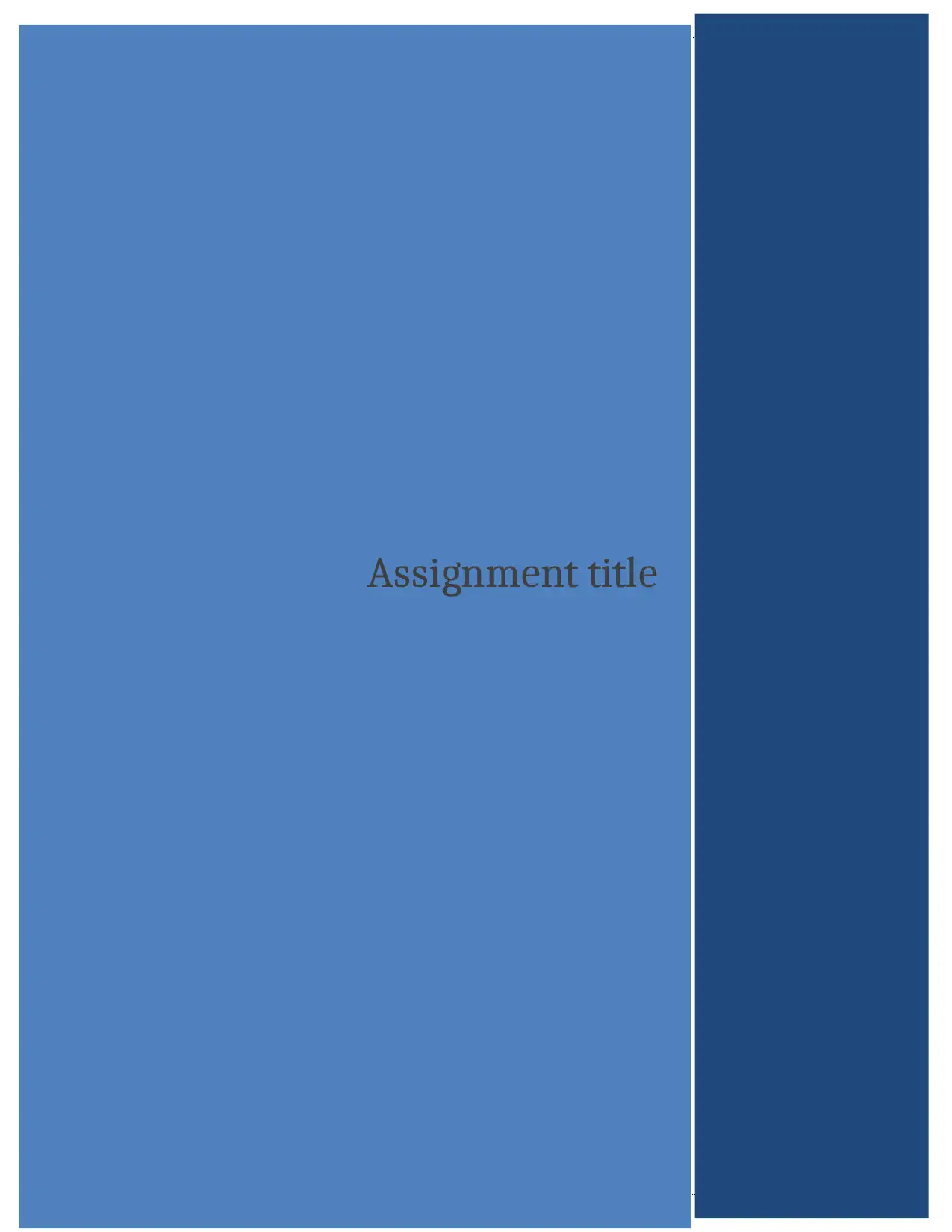
Assignment title
Secure Best Marks with AI Grader
Need help grading? Try our AI Grader for instant feedback on your assignments.

Table of Contents
Table of Contents..............................................................................................................1
Executive Summary...........................................................................................................2
Introduction........................................................................................................................2
Conclusion.........................................................................................................................3
References.........................................................................................................................5
Table of Contents..............................................................................................................1
Executive Summary...........................................................................................................2
Introduction........................................................................................................................2
Conclusion.........................................................................................................................3
References.........................................................................................................................5
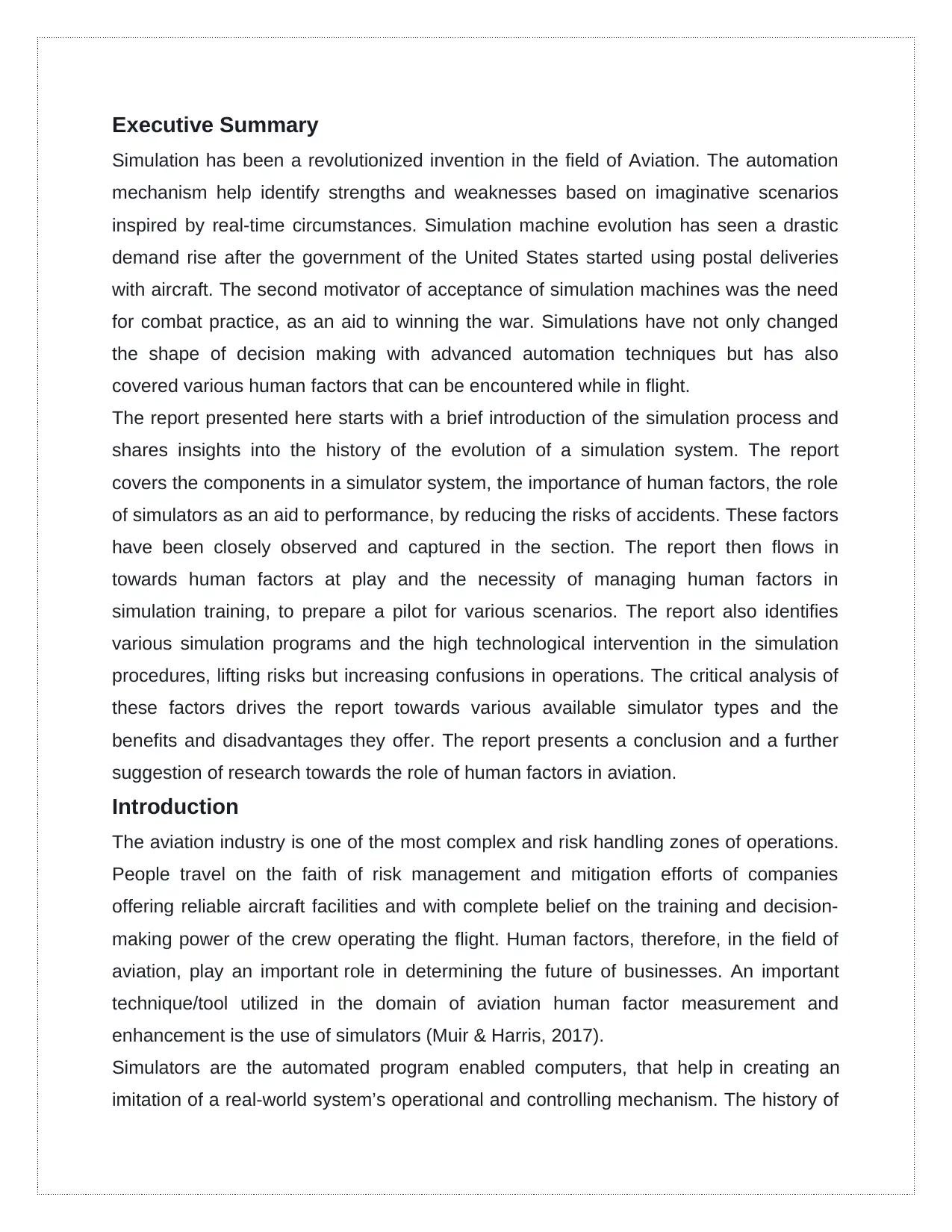
Executive Summary
Simulation has been a revolutionized invention in the field of Aviation. The automation
mechanism help identify strengths and weaknesses based on imaginative scenarios
inspired by real-time circumstances. Simulation machine evolution has seen a drastic
demand rise after the government of the United States started using postal deliveries
with aircraft. The second motivator of acceptance of simulation machines was the need
for combat practice, as an aid to winning the war. Simulations have not only changed
the shape of decision making with advanced automation techniques but has also
covered various human factors that can be encountered while in flight.
The report presented here starts with a brief introduction of the simulation process and
shares insights into the history of the evolution of a simulation system. The report
covers the components in a simulator system, the importance of human factors, the role
of simulators as an aid to performance, by reducing the risks of accidents. These factors
have been closely observed and captured in the section. The report then flows in
towards human factors at play and the necessity of managing human factors in
simulation training, to prepare a pilot for various scenarios. The report also identifies
various simulation programs and the high technological intervention in the simulation
procedures, lifting risks but increasing confusions in operations. The critical analysis of
these factors drives the report towards various available simulator types and the
benefits and disadvantages they offer. The report presents a conclusion and a further
suggestion of research towards the role of human factors in aviation.
Introduction
The aviation industry is one of the most complex and risk handling zones of operations.
People travel on the faith of risk management and mitigation efforts of companies
offering reliable aircraft facilities and with complete belief on the training and decision-
making power of the crew operating the flight. Human factors, therefore, in the field of
aviation, play an important role in determining the future of businesses. An important
technique/tool utilized in the domain of aviation human factor measurement and
enhancement is the use of simulators (Muir & Harris, 2017).
Simulators are the automated program enabled computers, that help in creating an
imitation of a real-world system’s operational and controlling mechanism. The history of
Simulation has been a revolutionized invention in the field of Aviation. The automation
mechanism help identify strengths and weaknesses based on imaginative scenarios
inspired by real-time circumstances. Simulation machine evolution has seen a drastic
demand rise after the government of the United States started using postal deliveries
with aircraft. The second motivator of acceptance of simulation machines was the need
for combat practice, as an aid to winning the war. Simulations have not only changed
the shape of decision making with advanced automation techniques but has also
covered various human factors that can be encountered while in flight.
The report presented here starts with a brief introduction of the simulation process and
shares insights into the history of the evolution of a simulation system. The report
covers the components in a simulator system, the importance of human factors, the role
of simulators as an aid to performance, by reducing the risks of accidents. These factors
have been closely observed and captured in the section. The report then flows in
towards human factors at play and the necessity of managing human factors in
simulation training, to prepare a pilot for various scenarios. The report also identifies
various simulation programs and the high technological intervention in the simulation
procedures, lifting risks but increasing confusions in operations. The critical analysis of
these factors drives the report towards various available simulator types and the
benefits and disadvantages they offer. The report presents a conclusion and a further
suggestion of research towards the role of human factors in aviation.
Introduction
The aviation industry is one of the most complex and risk handling zones of operations.
People travel on the faith of risk management and mitigation efforts of companies
offering reliable aircraft facilities and with complete belief on the training and decision-
making power of the crew operating the flight. Human factors, therefore, in the field of
aviation, play an important role in determining the future of businesses. An important
technique/tool utilized in the domain of aviation human factor measurement and
enhancement is the use of simulators (Muir & Harris, 2017).
Simulators are the automated program enabled computers, that help in creating an
imitation of a real-world system’s operational and controlling mechanism. The history of
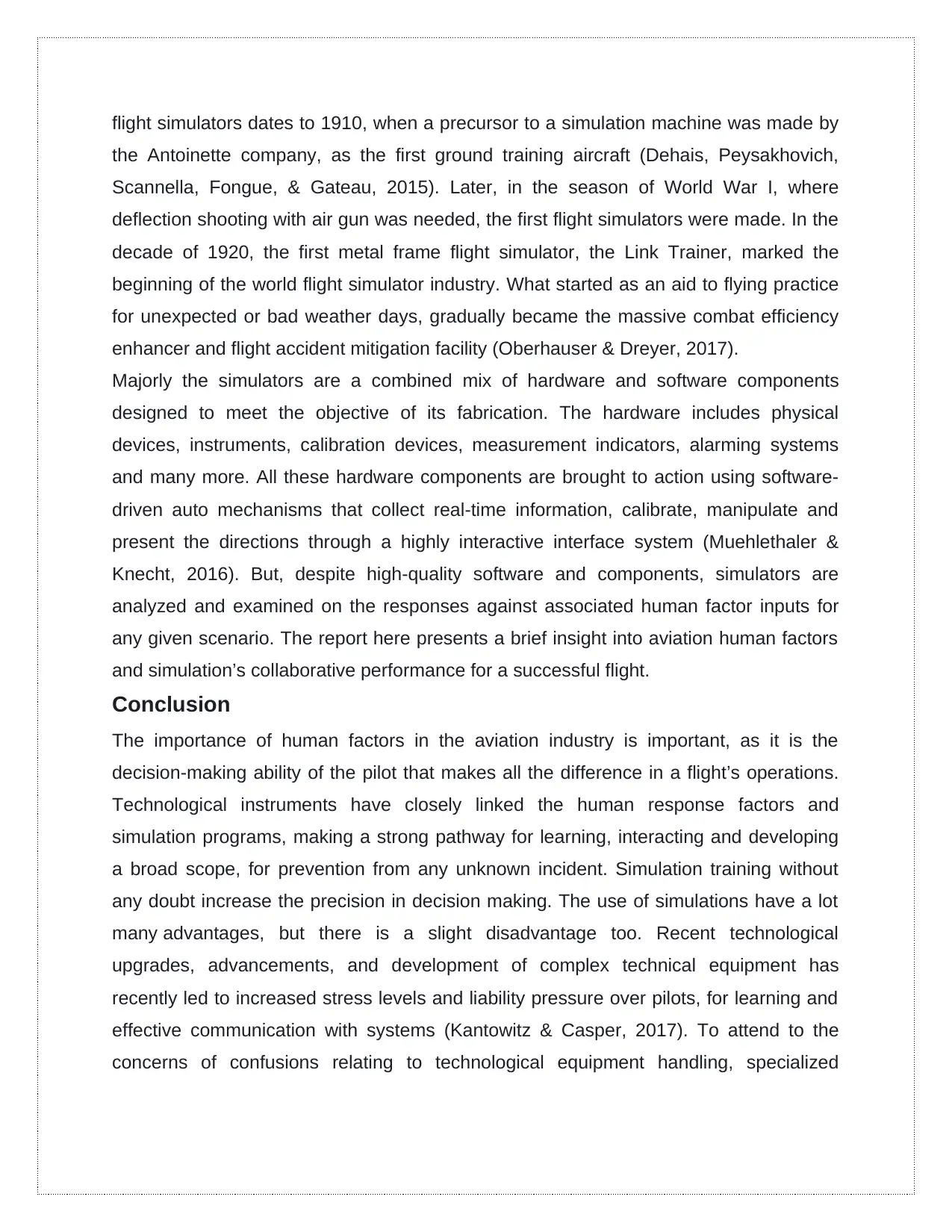
flight simulators dates to 1910, when a precursor to a simulation machine was made by
the Antoinette company, as the first ground training aircraft (Dehais, Peysakhovich,
Scannella, Fongue, & Gateau, 2015). Later, in the season of World War I, where
deflection shooting with air gun was needed, the first flight simulators were made. In the
decade of 1920, the first metal frame flight simulator, the Link Trainer, marked the
beginning of the world flight simulator industry. What started as an aid to flying practice
for unexpected or bad weather days, gradually became the massive combat efficiency
enhancer and flight accident mitigation facility (Oberhauser & Dreyer, 2017).
Majorly the simulators are a combined mix of hardware and software components
designed to meet the objective of its fabrication. The hardware includes physical
devices, instruments, calibration devices, measurement indicators, alarming systems
and many more. All these hardware components are brought to action using software-
driven auto mechanisms that collect real-time information, calibrate, manipulate and
present the directions through a highly interactive interface system (Muehlethaler &
Knecht, 2016). But, despite high-quality software and components, simulators are
analyzed and examined on the responses against associated human factor inputs for
any given scenario. The report here presents a brief insight into aviation human factors
and simulation’s collaborative performance for a successful flight.
Conclusion
The importance of human factors in the aviation industry is important, as it is the
decision-making ability of the pilot that makes all the difference in a flight’s operations.
Technological instruments have closely linked the human response factors and
simulation programs, making a strong pathway for learning, interacting and developing
a broad scope, for prevention from any unknown incident. Simulation training without
any doubt increase the precision in decision making. The use of simulations have a lot
many advantages, but there is a slight disadvantage too. Recent technological
upgrades, advancements, and development of complex technical equipment has
recently led to increased stress levels and liability pressure over pilots, for learning and
effective communication with systems (Kantowitz & Casper, 2017). To attend to the
concerns of confusions relating to technological equipment handling, specialized
the Antoinette company, as the first ground training aircraft (Dehais, Peysakhovich,
Scannella, Fongue, & Gateau, 2015). Later, in the season of World War I, where
deflection shooting with air gun was needed, the first flight simulators were made. In the
decade of 1920, the first metal frame flight simulator, the Link Trainer, marked the
beginning of the world flight simulator industry. What started as an aid to flying practice
for unexpected or bad weather days, gradually became the massive combat efficiency
enhancer and flight accident mitigation facility (Oberhauser & Dreyer, 2017).
Majorly the simulators are a combined mix of hardware and software components
designed to meet the objective of its fabrication. The hardware includes physical
devices, instruments, calibration devices, measurement indicators, alarming systems
and many more. All these hardware components are brought to action using software-
driven auto mechanisms that collect real-time information, calibrate, manipulate and
present the directions through a highly interactive interface system (Muehlethaler &
Knecht, 2016). But, despite high-quality software and components, simulators are
analyzed and examined on the responses against associated human factor inputs for
any given scenario. The report here presents a brief insight into aviation human factors
and simulation’s collaborative performance for a successful flight.
Conclusion
The importance of human factors in the aviation industry is important, as it is the
decision-making ability of the pilot that makes all the difference in a flight’s operations.
Technological instruments have closely linked the human response factors and
simulation programs, making a strong pathway for learning, interacting and developing
a broad scope, for prevention from any unknown incident. Simulation training without
any doubt increase the precision in decision making. The use of simulations have a lot
many advantages, but there is a slight disadvantage too. Recent technological
upgrades, advancements, and development of complex technical equipment has
recently led to increased stress levels and liability pressure over pilots, for learning and
effective communication with systems (Kantowitz & Casper, 2017). To attend to the
concerns of confusions relating to technological equipment handling, specialized
Paraphrase This Document
Need a fresh take? Get an instant paraphrase of this document with our AI Paraphraser
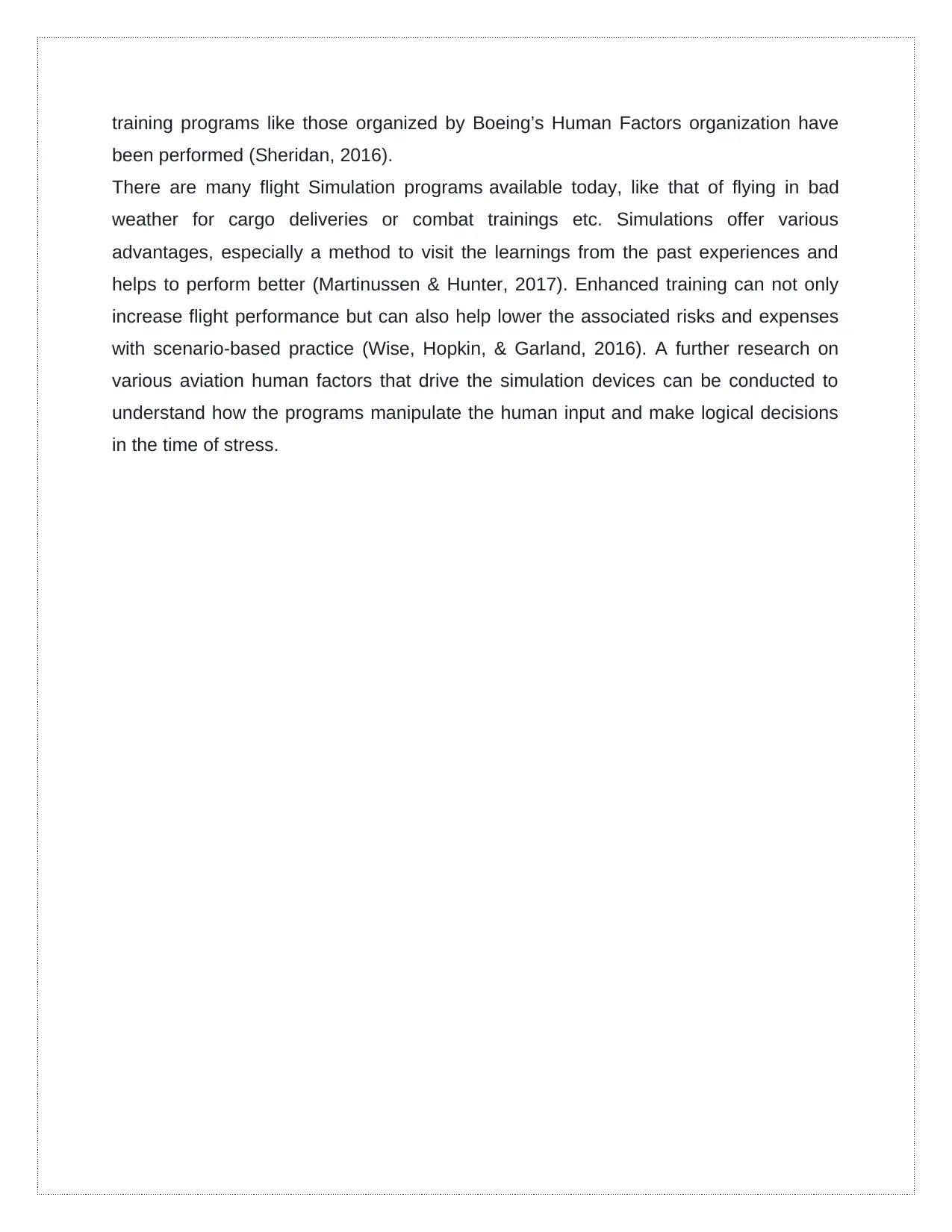
training programs like those organized by Boeing’s Human Factors organization have
been performed (Sheridan, 2016).
There are many flight Simulation programs available today, like that of flying in bad
weather for cargo deliveries or combat trainings etc. Simulations offer various
advantages, especially a method to visit the learnings from the past experiences and
helps to perform better (Martinussen & Hunter, 2017). Enhanced training can not only
increase flight performance but can also help lower the associated risks and expenses
with scenario-based practice (Wise, Hopkin, & Garland, 2016). A further research on
various aviation human factors that drive the simulation devices can be conducted to
understand how the programs manipulate the human input and make logical decisions
in the time of stress.
been performed (Sheridan, 2016).
There are many flight Simulation programs available today, like that of flying in bad
weather for cargo deliveries or combat trainings etc. Simulations offer various
advantages, especially a method to visit the learnings from the past experiences and
helps to perform better (Martinussen & Hunter, 2017). Enhanced training can not only
increase flight performance but can also help lower the associated risks and expenses
with scenario-based practice (Wise, Hopkin, & Garland, 2016). A further research on
various aviation human factors that drive the simulation devices can be conducted to
understand how the programs manipulate the human input and make logical decisions
in the time of stress.
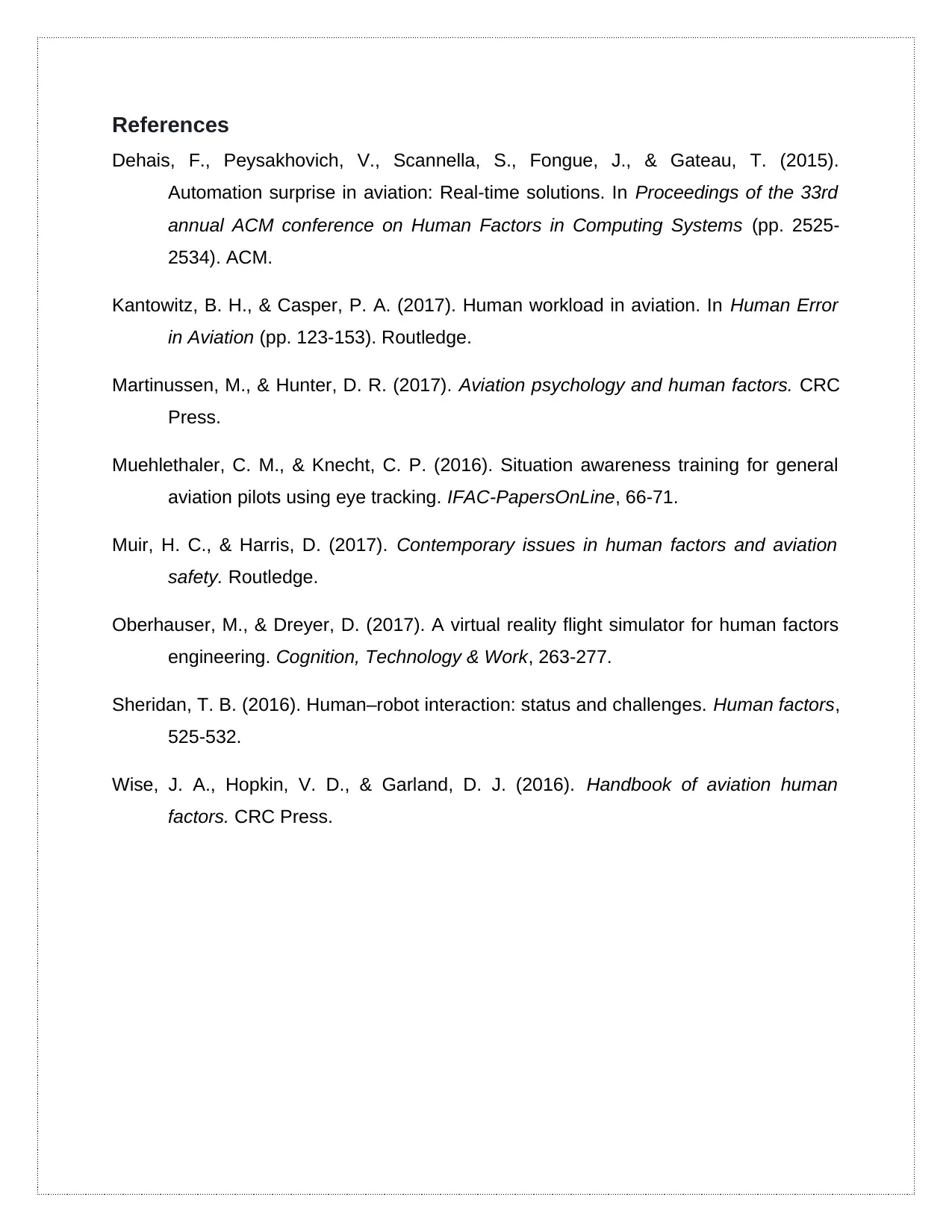
References
Dehais, F., Peysakhovich, V., Scannella, S., Fongue, J., & Gateau, T. (2015).
Automation surprise in aviation: Real-time solutions. In Proceedings of the 33rd
annual ACM conference on Human Factors in Computing Systems (pp. 2525-
2534). ACM.
Kantowitz, B. H., & Casper, P. A. (2017). Human workload in aviation. In Human Error
in Aviation (pp. 123-153). Routledge.
Martinussen, M., & Hunter, D. R. (2017). Aviation psychology and human factors. CRC
Press.
Muehlethaler, C. M., & Knecht, C. P. (2016). Situation awareness training for general
aviation pilots using eye tracking. IFAC-PapersOnLine, 66-71.
Muir, H. C., & Harris, D. (2017). Contemporary issues in human factors and aviation
safety. Routledge.
Oberhauser, M., & Dreyer, D. (2017). A virtual reality flight simulator for human factors
engineering. Cognition, Technology & Work, 263-277.
Sheridan, T. B. (2016). Human–robot interaction: status and challenges. Human factors,
525-532.
Wise, J. A., Hopkin, V. D., & Garland, D. J. (2016). Handbook of aviation human
factors. CRC Press.
Dehais, F., Peysakhovich, V., Scannella, S., Fongue, J., & Gateau, T. (2015).
Automation surprise in aviation: Real-time solutions. In Proceedings of the 33rd
annual ACM conference on Human Factors in Computing Systems (pp. 2525-
2534). ACM.
Kantowitz, B. H., & Casper, P. A. (2017). Human workload in aviation. In Human Error
in Aviation (pp. 123-153). Routledge.
Martinussen, M., & Hunter, D. R. (2017). Aviation psychology and human factors. CRC
Press.
Muehlethaler, C. M., & Knecht, C. P. (2016). Situation awareness training for general
aviation pilots using eye tracking. IFAC-PapersOnLine, 66-71.
Muir, H. C., & Harris, D. (2017). Contemporary issues in human factors and aviation
safety. Routledge.
Oberhauser, M., & Dreyer, D. (2017). A virtual reality flight simulator for human factors
engineering. Cognition, Technology & Work, 263-277.
Sheridan, T. B. (2016). Human–robot interaction: status and challenges. Human factors,
525-532.
Wise, J. A., Hopkin, V. D., & Garland, D. J. (2016). Handbook of aviation human
factors. CRC Press.
1 out of 6
Your All-in-One AI-Powered Toolkit for Academic Success.
+13062052269
info@desklib.com
Available 24*7 on WhatsApp / Email
![[object Object]](/_next/static/media/star-bottom.7253800d.svg)
Unlock your academic potential
© 2024 | Zucol Services PVT LTD | All rights reserved.

